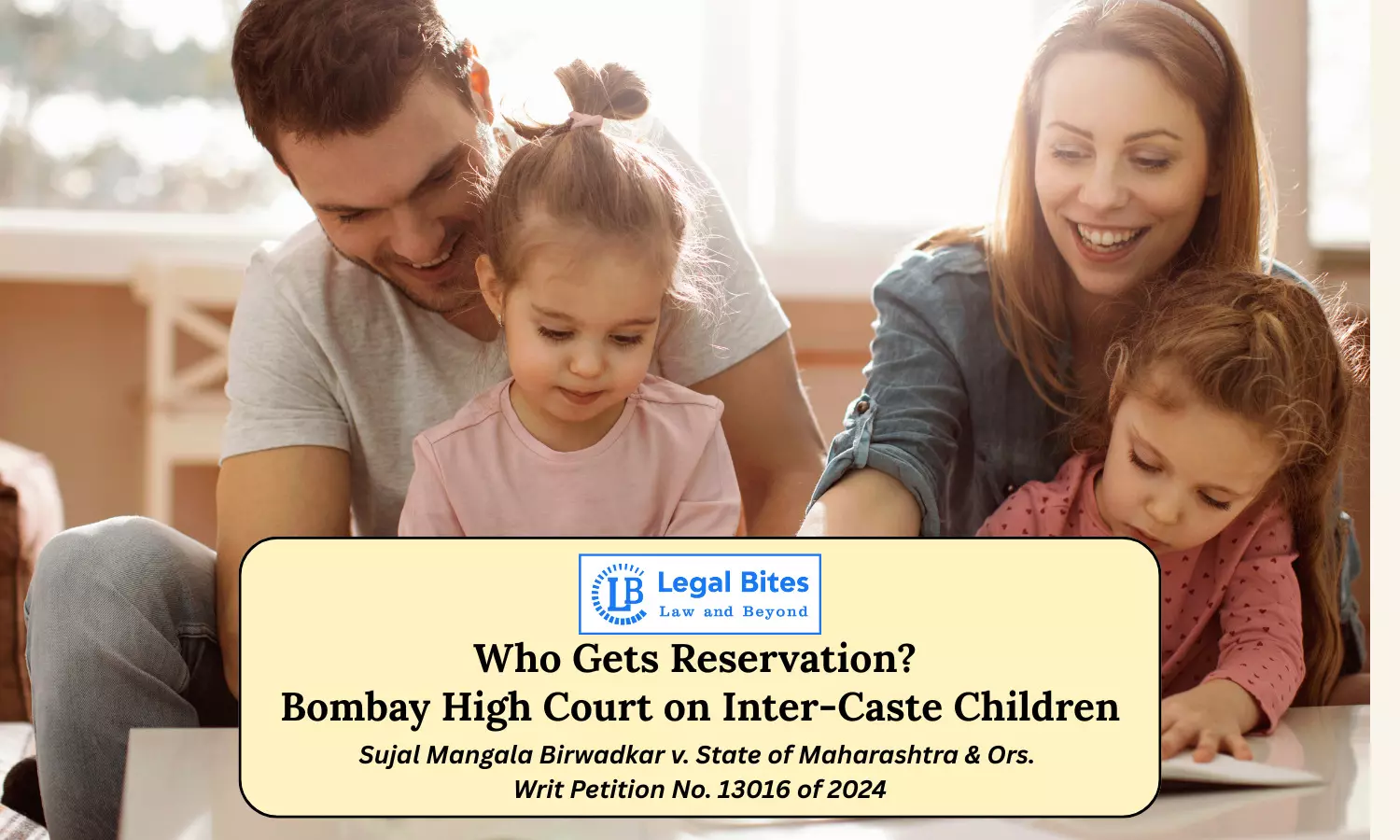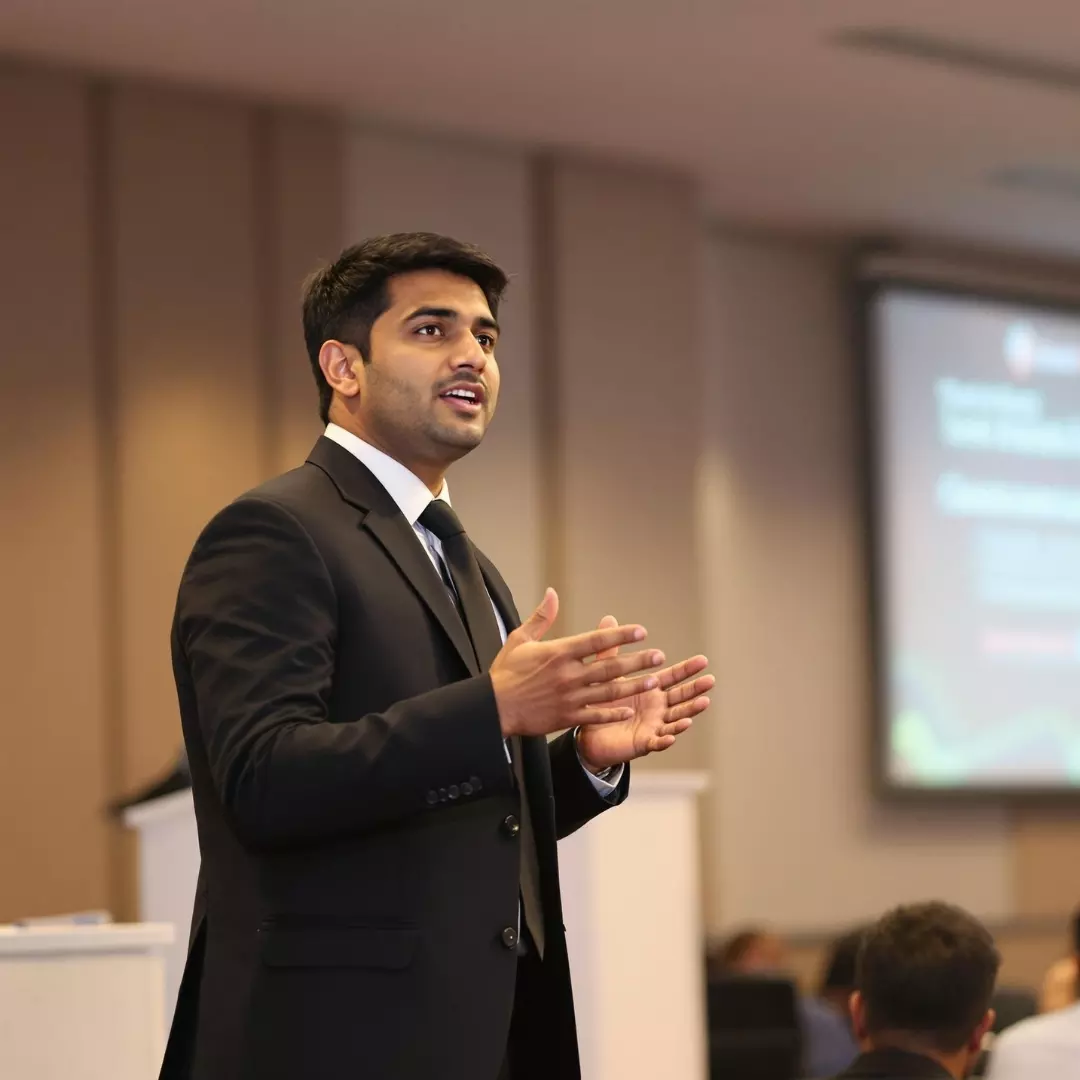Is Parental Caste Alone Enough for Reservation? What Did Bombay High Court Say About Inter-Caste Children?
Read the full analysis of the Sujal Mangala Birwadkar case and its impact on reservation eligibility for inter-caste children in India.

Caste-based reservation remains a cornerstone of India’s social justice architecture, aiming to remedy centuries of discrimination and provide equitable opportunities to marginalised communities. However, the dynamic of inter-caste marriages and children born out of such unions raises complex questions: Can a child claim reservation solely based on the caste of one parent?
What happens when parents come from different social backgrounds, especially when one belongs to a reserved category and the other to a general or upper caste?
The Bombay High Court, in the recent case of Sujal Mangala Birwadkar v. State of Maharashtra & Ors. (Writ Petition No. 13016 of 2024, decided on 20 June 2025), dealt directly with this issue. The judgment clarified critical criteria for claiming reservation by inter-caste children, emphasising that mere lineage or documentary proof of parental caste is not sufficient; the real-life experience of deprivation, discrimination, and social environment plays a decisive role.
This article explores the facts, legal reasoning, and wider implications of this ruling.
Background of the Case
Factual Matrix
Petitioner: Sujal Mangala Birwadkar, 18 years old, student.
Parental Background:
Father: Hindu Agri (not a Scheduled Caste).
Mother: Chambhar (a Scheduled Caste).
Marital History: Parents married in 2004, later divorced in 2016. The child's custody was always with the mother.
School Records: Initially, the petitioner’s caste was recorded as ‘Hindu Agri’ (father’s caste) in the primary school. Post-divorce, in secondary school admissions, the mother recorded the petitioner as ‘Chambhar’ and changed his name to reflect her surname.
Claim for Caste Certificate: In 2023, the mother sought a Scheduled Caste certificate for the petitioner, which was initially issued but sent for scrutiny by the Caste Certificate Scrutiny Committee, which ultimately rejected it.
Petition: The petitioner approached the Bombay High Court to challenge the Scrutiny Committee's rejection and sought a declaration that he belongs to the Chambhar (Scheduled Caste) community.
Issues Before the Court
- Whether the child of inter-caste parents (one SC, one not SC) can claim Scheduled Caste status solely on the basis of the mother’s caste?
- Whether the lived experience of the child—upbringing, social environment, and any experienced deprivation or discrimination—is a relevant factor in granting a caste validity certificate?
- What evidentiary burden lies on such applicants to prove eligibility for reservation benefits?
Arguments by Parties
Petitioner’s Side
- The father (upper caste) never cared for or supported the petitioner.
- Custody and upbringing were entirely with the mother, who is from a Scheduled Caste.
- The petitioner faced indignities and disadvantages typical to a member of the Scheduled Caste community.
- The Scrutiny Committee’s decision was contrary to facts and evidence.
State’s Response
The Vigilance Inquiry Report showed:
- The mother was employed in the Central Police, earning well and capable of supporting the child.
- The father, despite being separated, made attempts to stay in touch but was not permitted.
- Throughout schooling, the petitioner availed of advantages as a member of the upper caste, as reflected in school records.
- The maternal family did not live in a deprived or backward area and was well-off.
- No substantive evidence was provided to show that the petitioner suffered deprivation or discrimination due to his mother’s caste.
Bombay High Court’s Analysis
The Division Bench of Justice Revati Mohite Dere and Justice Dr. Neela Gokhale systematically addressed the legal and social complexities involved.
Key Observations
1) Mere Parentage is Not Enough
The Court reiterated that a child cannot be declared as a Scheduled Caste member merely by virtue of parentage (i.e., having an SC parent). The critical test is the lived experience:
“no evidence was brought on record… to demonstrate that by virtue of his mother being a member of the Scheduled Caste, he suffered deprivations, indignities, humiliation, and any other challenges normally suffered by a person belonging to a Scheduled Caste community”
2) Requirement of Demonstrating Discrimination
- The Court relied on its own previous decisions and the Supreme Court’s guidance, highlighting that an applicant must show they have experienced social disabilities, humiliation, and deprivation commonly associated with the reserved category. This includes:
- Being treated shabbily or insulted because of caste.
- Facing educational or employment disadvantages due to caste.
- If the child had the advantage of an upper-caste background for most of their upbringing, this claim would fail.
3) Material Circumstances Considered
The Vigilance Report revealed:
- The mother’s stable, government employment.
- Absence of deprivation or lack of resources.
- Maternal family’s comfortable socio-economic status.
- No proof of the mother suffering humiliation or manifest discrimination, nor any evidence of such suffering being transferred to the petitioner.
4) Changing School Records Not Conclusive
The fact that the caste was later changed in school records, post-divorce, did not in itself establish that the child faced any caste-based adversity.
5) Social Setting is Crucial
The Court pointedly noted:
"He had the advantage of his father’s upper caste during his schooling days and his caste was recorded as ‘Hindu Agri’ in his school records… There is nothing on record to indicate that the Petitioner’s mother suffered any humiliation, which was manifested on the Petitioner”
6) No Handicap or Disadvantage Proven
The Petitioner received a good education, was not discriminated against, and did not suffer from any of the disadvantages typically faced by members of the Scheduled Caste community.
7) Precedent Cited
The Court referred to its earlier judgment in Swanubhuti Jivraj Jain v. State of Maharashtra (2025 SCC Online Bom 322), and Supreme Court precedent, to reaffirm that “the real test is not what caste the mother or father belonged to, but what was the social environment in which the child was brought up.
Key Highlights of the Verdict
The Bombay High Court dismissed the petition, holding that the petitioner could not be considered a member of the Scheduled Caste community for reservation or benefits merely because of his mother’s caste. The absence of lived experience of deprivation or discrimination, and the advantage of an upper-caste upbringing, were fatal to his claim.
Justice Revati Mohite Dere and Justice Dr. Neela Gokhale observed:
“In the light of the peculiar facts as above and taking into account the documents before us, it is clear that the Petitioner had good education, was never discriminated against and did not suffer any disadvantages on account of his mother belonging to a Scheduled Caste community. He did not suffer any handicap and did have an advantageous start in life. We are thus, unable to accept that he is eligible to be declared as a person from the ‘Chambhar’ community. We are not inclined to allow the Petition. Petition is dismissed.”
Legal Principles Established
1. Lived Experience > Lineage
For inter-caste children, what matters is not just birth or documents, but the real social environment and lived experience—did the child actually suffer the disabilities and discrimination attached to the reserved caste?
2. Burden of Proof
The onus is on the applicant to prove deprivation, humiliation, and lack of opportunities due to caste. Simple parentage or paperwork is insufficient.
3. Economic and Social Status of Family
The socio-economic background, education, parental employment, and overall upbringing are decisive factors.
4. Changing Records is Not Enough
Subsequent change of caste in records, especially after major events (such as divorce), does not by itself show that the individual faced the social disadvantages necessary for reservation.
Comparative Perspective: Supreme Court Guidance
This approach of the Bombay High Court is fully aligned with the Supreme Court’s evolving jurisprudence. Key cases include:
- Rameshbhai Dabhai Naika v. State of Gujarat (2012) 3 SCC 400: The Supreme Court held that in inter-caste marriages, if the child is brought up as a member of the mother’s community (especially if she belongs to an SC/ST), then the child can claim benefits, but only if it is proven that the child faced the disadvantages and discrimination of that community.
- Anjan Kumar v. Union of India (2006) 3 SCC 257: The Supreme Court clarified that in the case of children born to inter-caste marriages, the crucial consideration is the upbringing and whether the child was treated as a member of the reserved community.
- V.V. Giri v. D. Suri Dora (1959 AIR 1318): It was held that mere proof of descent is not sufficient; the surrounding circumstances and acceptance by the community are equally important.
Implications of the Judgment
For Students and Applicants
- Children of inter-caste parents seeking reservation must go beyond mere documentation and show real-life experience of social or economic backwardness and discrimination due to their claimed caste.
- Applicants should be prepared to provide evidence of upbringing, social acceptance, community environment, and possible humiliation or deprivation.
For Authorities
- Scrutiny Committees must conduct thorough inquiries into the actual social and economic circumstances of claimants, not just rely on parentage or school records.
For Policy and Law
- The judgment reiterates the principle that reservation is not a mechanical benefit linked only to birth, but a tool for genuine social upliftment.
- As inter-caste marriages become more common, authorities and courts will need to be vigilant against misuse, while ensuring that deserving individuals are not denied on hyper-technicalities.
Conclusion
The Bombay High Court, in Sujal Mangala Birwadkar v. State of Maharashtra & Ors. (2025) has authoritatively answered a recurring question in reservation jurisprudence: Parental caste alone is not enough for claiming reservation benefits. The child of inter-caste parents must prove actual social disadvantage and discrimination akin to members of the reserved community. As society evolves, so must our understanding of caste, identity, and social justice.
This ruling is likely to influence similar disputes across India, urging authorities, applicants, and courts to look beyond paperwork and ask the most important question: Did the claimant actually live the life of a member of the Scheduled Caste community?
Important Link
Law Library: Notes and Study Material for LLB, LLM, Judiciary, and Entrance Exams

